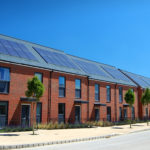Roof systems manufacturer, Marley, is urging local authorities and housing associations considering applying for a proportion of the £3.8bn of funding available via the Social Housing Decarbonisation Fund (SHDF) to maximise grant opportunities with the inclusion of solar PV.
Wave 2.1 of the Social Housing Decarbonisation Fund competition will see a share of the £800m funding allocated to social housing providers to improve the energy efficiency of homes below Energy Performance Certificate (EPC) C.
With applications open until 18th November 2022, Marley has outlined the ways social housing providers can maximise available funding opportunities in line with planned maintenance schedules via the inclusion of solar PV.
For local authorities applying to the SHDF, the following advice applies:
Conduct a detailed assessment of all current housing stock below EPC C
Assess all existing housing stock to establish which properties should be addressed first. A good place to start is by looking at properties with the lowest EPC rating. The inclusion of solar PV may generate additional points which can be used towards a property’s EPC rating, which is the primary objective of the SHDF, whilst reducing fuel bills for tenants.
Review planned and capital maintenance programs for the next three years
Applicants need to fund at least 50% from their resources, so it is important to carefully review existing housing stock, as combining capital works, or planned maintenance, with a bid could make any funding allocated go further. Many social housing properties built in the 1950s and 1960s may have roofs which are coming to the end of their life expectancy. SHDF covers integrated solar PV, so replacing a section of the roof tiles will save on both material and labour costs, meaning landlords can reapportion planned maintenance budgets to other properties in their housing stock.
Engage with manufacturers and supply chains early
SHDF funding must be drawn down by 31st March 2025 and works must be completed by 30th June 2025, so although there is a longer delivery window, there is also a minimum bid level of 100 homes. It is important to ensure that works are conducted as efficiently as possible to meet the timescales involved. Recent changes to Part L have seen demand for solar PV grow exponentially; so, to ensure continuity of supply, early engagement is advised.
To this end, Marley can support local authorities with NBS specifications, in depth calculations of the kilowatt output from its Marley SolarTile solution, together with assistance on surveying existing housing stock to determine the suitability of solar PV.
Stuart Nicholson, Roof Systems Director at Marley, commented: “The Social Housing Decarbonisation Fund, offers valuable funding to local authorities seeking to improve the energy efficiency of their housing stock. However, it’s important that authorities carefully consider how this funding can be maximised. The inclusion of solar PV, which can be potentially used as part of a fabric first approach, offers an important way of doing this. Not only may it contribute towards improving a property’s overall EPC rating, but it could also see local authorities maximise their planned maintenance budgets, specifically when including an integrated solar PV solution.”
To find out how Marley can support with your SHDF application, visit: https://www.marley.co.uk/shdf?utm_source=shdf-digital-press-release&utm_medium=pr&utm_campaign=solar
Header image showing a housing scheme in Bicester featuring integrated solar PV ©Viridian Solar









